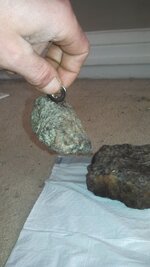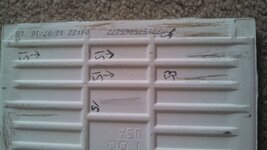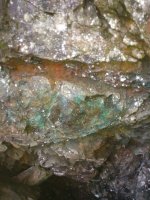I've found a couple sulfides, hopefully I'm getting closer to the origin, and I was wondering if you guys could help me out identifying them and this blue mineralization in a few spots in my area.
Here are the sulfides and the nuggets that came out of the one:
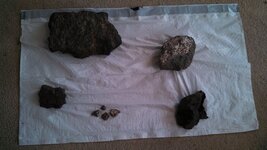
This sulfide has a coating of what I believe to be alunite on it - its just gorgeous!:
"S1"
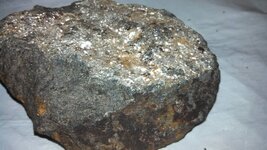
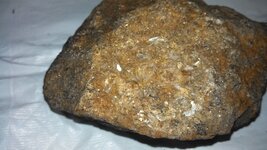
Would someone mind elaborating on the alunite/sulfide as to what the sulfide may be and why the alunite? formed on it? Am I getting closer to the origin of deposit with this alunite on the sulfide?
Im assuming this is a sulfide and these are the nuggets which reside inside that I had XRFd:
"S2"
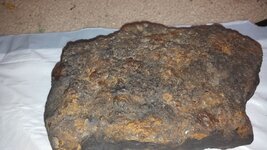
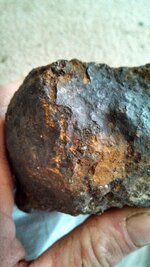
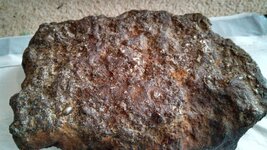
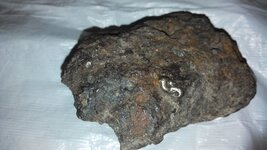
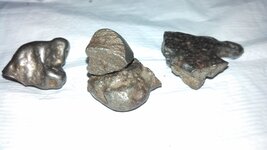
Analysis results (Slight variation between the 3 nuggets I had placed in the device):
90% FE
6% CU
1% Ti
Less than or around 1% - Zn, Mg or Mn, Cr or Co (I forget the exact percentages and trace elements as I was let down it wasnt the assumed awaruite or platinum ) and maybe there was a tad vanadium in there too. I just remember the main constituents were Fe,Cu,Ti. There was no nickel detected by the XRF or by my DMG test kit.
) and maybe there was a tad vanadium in there too. I just remember the main constituents were Fe,Cu,Ti. There was no nickel detected by the XRF or by my DMG test kit.
Bornite?:
"S3"
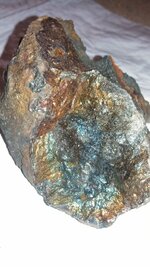
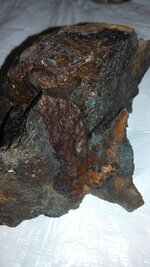
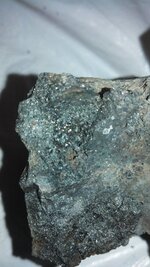
And finally the mystery mineralization! In my area, at times I crack open rocks or chunk open a protrusion of a wall/hill outcrop and find a deep blue/turquoise coloring inside. I take them home until I learn more about geology and I've noticed that the color fades. Sometimes color fades within a day or two, and the color fade is different too. Sometimes it just disappears and only few specimens have turned into a green color and stayed green. Some retract to the darker areas and turn almost like a black. I'm guessing that this is some type of copper enrichment?
The one rock looks to me like a basalt or similar makeup and the others are less dense i dont know whats. The rock that turned green was chunked off of a hillside embankment exposure:
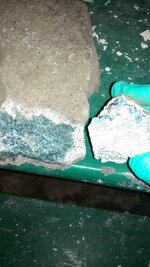
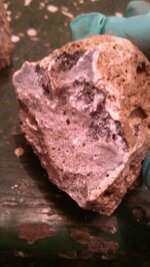
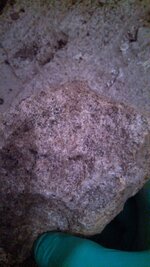
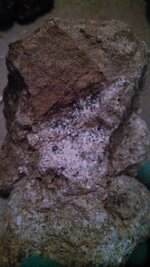
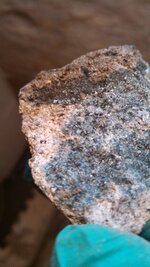
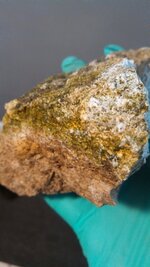
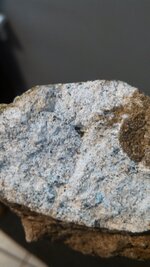
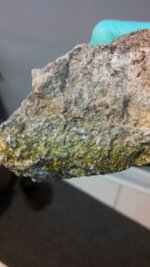
The second picture here doesn't have great lighting, but the rock also is exhibiting the fade I was talking about. Yesterday it was so bright and vibrant and now its dulling and fading.
The fourth picture looks like thats a chunk of sandstone stuck in the matrix if that helps in identifying the matrix?
Here are the sulfides and the nuggets that came out of the one:

This sulfide has a coating of what I believe to be alunite on it - its just gorgeous!:
"S1"


Would someone mind elaborating on the alunite/sulfide as to what the sulfide may be and why the alunite? formed on it? Am I getting closer to the origin of deposit with this alunite on the sulfide?
Im assuming this is a sulfide and these are the nuggets which reside inside that I had XRFd:
"S2"





Analysis results (Slight variation between the 3 nuggets I had placed in the device):
90% FE
6% CU
1% Ti
Less than or around 1% - Zn, Mg or Mn, Cr or Co (I forget the exact percentages and trace elements as I was let down it wasnt the assumed awaruite or platinum
Bornite?:
"S3"



And finally the mystery mineralization! In my area, at times I crack open rocks or chunk open a protrusion of a wall/hill outcrop and find a deep blue/turquoise coloring inside. I take them home until I learn more about geology and I've noticed that the color fades. Sometimes color fades within a day or two, and the color fade is different too. Sometimes it just disappears and only few specimens have turned into a green color and stayed green. Some retract to the darker areas and turn almost like a black. I'm guessing that this is some type of copper enrichment?
The one rock looks to me like a basalt or similar makeup and the others are less dense i dont know whats. The rock that turned green was chunked off of a hillside embankment exposure:








The second picture here doesn't have great lighting, but the rock also is exhibiting the fade I was talking about. Yesterday it was so bright and vibrant and now its dulling and fading.
The fourth picture looks like thats a chunk of sandstone stuck in the matrix if that helps in identifying the matrix?
Amazon Forum Fav 👍
Last edited:


